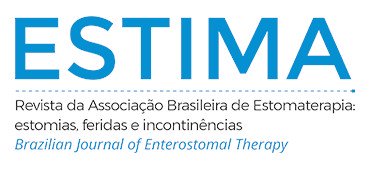UTILIZAÇÃO DO CLORETO DE DIALQUIL CARBAMOIL NA PREVENÇÃO E TRATAMENTO DE BIOFILME EM FERIDAS
Resumo
Objetivos: Objetivou-se identificar os benefícios na utilização do Cloreto de Dialquil Carbamoil para tratamento de biofilmes em feridas. Métodos: Trata-se de uma revisão integrativa de literatura que visou responder à questão norteadora: “Quais os benefícios do uso de Cloreto de Dialquil Carbamoil na cicatrização de lesões de pele?”. As etapas de seleção dos artigos resultaram em 13 artigos inclusos. Resultados: Os artigos selecionados foram agrupados em dois grupos, a saber: prevenção e tratamento de infecção em feridas e prevenção de infecção de sítio cirúrgico, sendo nove produções no primeiro grupo e quatro no segundo. Os estudos demonstraram que o Cloreto de Dialquil Carbamoil atenua os sintomas de colonização, como odor, queixas álgicas e exsudação, além disso, auxilia no gerenciamento profilático do biofilme da ferida. As evidências apontam que coberturas com Cloreto de Dialquil Carbamoil não possuem efeitos adversos, tornando-se opções viáveis e seguras para lesões crônicas, agudas e, principalmente, infectadas. Conclusão: Identificou-se que o Cloreto de Dialquil Carbamoil foi capaz de promover ações benéficas ao tratamento de feridas, especialmente as de maior complexidade. A escolha adequada das coberturas e dos curativos pode contribuir com a utilização racional das tecnologias existentes e dos antimicrobianos, culminando em redução de custos e promoção de qualidade de vida aos indivíduos com feridas crônicas.
Downloads
Métricas
Referências
Malone M, Bjarnsholt T, McBain AJ, James GA, Stoodley P, Leaper D et al. The prevalence of biofilms in chronic wounds: a systematic review and meta-analysis of published data. J Wound Care. 2017;26(1):20–5. https://doi.org/10.12968/jowc.2017.26.1.20
Murphy C, Atkin L, Swanson T, Tachi M, Tan YK, Vega M et al. Consensus Document. Abordar feridas de difícil cicatrização com uma estratégia de intervenção precoce antibiofilme: higienização da ferida. J Wound Care 2020;29(Suppl3b):s1-s28. Disponível em: https://www.woundhygiene.com/media/bs3bxuod/portugal_jwc_convatec_wound-hygiene-28pp_14-feb_ca-por.pdf
Jones CM, Rothermel AT, Mackay DR. Evidence−Based Medicine: Wound Management. Plast Reconstr Surg. 2017;140(1):201e-216e. https://doi.org/10.1097/PRS.0000000000003486
Viviana SGC, Thum M, Aline OR, Beloto Silva O, Franco Coelho M, Medeiros da Silva Queiroz W et al. Analysis of “1st Brazilian Recommendation for Biofilm Management in Chronic and Complex Wounds.” ESTIMA, Braz J Enterostomal Ther. 2019;17:e1819. https://doi.org/https://doi.org/10.30886/estima.v17.783_IN
Totty JP, Hitchman LH, Cai PL, Harwood AE, Wallace T, Carradice D et al. A pilot feasibility randomised clinical trial comparing dialkylcarbamoylchloride-coated dressings versus standard care for the primary prevention of surgical site infection. Int Wound J. 2019;16(4):883–90. https://doi.org/10.1111/iwj.13113
Botelho LLR, Cunha CC de A, Macedo M. O Método Da Revisão Integrativa Nos Estudos Organizacionais. Gestão e Sociedade. 2011;5(11):121−136. https://doi.org/10.21171/ges.v5i11.1220
Galvão TF, Pereira MG. Revisões sistemáticas da literatura: passos para sua elaboração. Epidemiol e Servi Saúde. 2014;23(1):183–4. http://doi.org/10.5123/S1679-49742014000100018
Pinto AM, Cerqueira MA, Bañobre-Lópes M, Pastrana LM, Sillankorva S. Bacteriophages for Chronic Wound Treatment: fromTraditional to Novel Delivery Systems. Viruses. 2020;12(2):235. https://doi.org/10.3390/v12020235
Powers JG, Higham C, Broussard K, Phillips TJ. Wound healing and treating wounds: Chronic wound care and management. J Am Acad Dermatol. 2016;74(4):607-25. https://doi.org/10.1016/j.jaad.2015.08.070
Bowler PG. Antibiotic resistance and biofilm tolerance: a combined threat in the treatment of chronic infections. J Wound Care. 2018;27(5):273–7. https://doi.org/10.12968/jowc.2018.27.5.273
Pieper B, Sobeck J, Kaljee L, Templin TN. A Descriptive Study Using an Intercept Survey: Knowledge, Attitudes, Beliefs, and Behaviors About Systemic Antibiotic Use in Adults Who Reported a Wound Within the Previous Year. J Wound Ostomy Continence Nurs. 2020;47(1):20–5. https://doi.org/10.1097/WON.0000000000000612
Meuleneire F. Infection management: The use of DACC-coated dressings in the management of wound infection. Br J Nurs. 2012;21(Sup2):4–7. https://doi.org/10.12968/bjon.2012.21.Sup2.4
Chadwick P, Ousey K. Bacterial-binding dressings in the management of wound healing and infection prevention: a narrative review. J Wound Care. 2019;28(6):370–82. https://doi.org/10.12968/jowc.2019.28.6.370
Romain B, Mielcarek M, Delhorme JB, Meyer N, Brigand C, Rohr S et al. Dialkylcarbamoyl chloride-coated versus alginate dressings after pilonidal sinus excision: a randomized clinical trial (SORKYSA study). BJS open. 2020;4(2):225–31. https://doi.org/10.1002/bjs5.50259
Boyar V. Efficacy of dialkylcarbamoylchloride-coated dressing in management of colonized or infected neonatal and pediatric wounds. J Wound Ostomy Continence Nurs. 2016;43(5):547–50. https://doi.org/10.1097/WON.0000000000000266
Biter LU, Beck GMN, Mannaerts GHH, Stok MM, Ham AC, Grotenhuis BA. The use of negative-pressure wound therapy in pilonidal sinus disease: a randomized controlled trial comparing negative-pressure wound therapy versus standard open wound care after surgical excision. Dis Colon Rectum. 2014;57(12):1406–11. https://doi.org/10.1097/DCR.0000000000000240
Bua N, Smith GE, Totty JP, Pan D, Wallace T, Carradice D et al. Dialkylcarbamoyl Chloride Dressings in the Prevention of Surgical Site Infections after Nonimplant Vascular Surgery. Ann Vasc Surg. 2017;44:387–92. https://doi.org/10.1016/j.avsg.2017.03.198
Dwiyana RF, Gondokaryono SP, Rahardja JI, Diana IA, Yogya Y, Gunawan H. Clinical efficacy of dialkylcarbamoylchloride-coated cotton acetate dressing versus combination of normal saline dressing and 2% mupirocin ointment in infected wounds of epidermolysis bullosa. Dermatol Ther. 2019;32(5):e13047. https://doi.org/10.1111/dth.13047
Denyer J. Infection management: Antimicrobial management for children with epidermolysis bullosa. Br J Nurs. 2012;21(Sup2):8–10. https://doi.org/10.12968/bjon.2012.21.Sup2.8
Bruce Z. Using Cutimed® Sorbact® hydroactive on chronic infected wounds. Wounds UK. 2012;8(1):119–29. Disponível em: https://www.researchgate.net/publication/286986985_Using_CutimedR_SorbactR_hydroactive_on_chronic_infected_wounds
Lee JW, Park SH, Suh IS, Jeong HS. A comparison between DACC with chlorhexidine acetate-soaked paraffin gauze and foam dressing for skin graft donor sites. J Wound Care. 2018;27(1):28–35. https://doi.org/10.12968/jowc.2018.27.1.28
Downloads
Publicado
Como Citar
Edição
Seção
Licença
Copyright (c) 2021 Paula de Souza Silva Freitas, Lucas Dalvi Armond Rezende, Kelly Eduarda de Jesus Silva, Bruno Henrique Fiorin, Ramon Araújo dos Santos, Aline Oliveira Ramalho

Este trabalho está licenciado sob uma licença Creative Commons Attribution 4.0 International License.

























